Realms of the Wretched: D&D Cosmology featured art from this article is provided from Baldur’s Gate: Descent into Avernus by Wizards of the Coast.
This article contains affiliate links that add gold to our coffers.
“But if the promise of life and paradise everlasting is not enough to inspire the souls listening today to righteousness, then let me deliver a warning to those who may die in wickedness. The lower realms of the cosmos are the final resting place of liars, betrayers, and murderers of all types. The souls sent to these hells will spend eternity in pain and agony. Take heed! Amend your ways! You do not need to suffer the torture of devils and demons! You do not need to suffer the maddening winds that scrape your flesh from your bones! If you turn to the gods and their precepts once more, you may avoid the terrible fate that befall so many poor souls that tread this mortal world. Amend your ways, serve the gods, and avoid these terrible hells!”
–continued from a sermon given by Archpriest Krassus in the year 372.
Change Your Multiverse
From the description of the cosmos, it may sound like the planar structure is relatively set in stone in 5th edition. However, looking at previous editions, I would say this conception would be a mistake. Many other rulebooks from editions past talk about cataclysmic shifts in cosmic power that realign the planes. These types of dramatic events can provide great fodder for a setting or the lore of a campaign. One type of such event could be a total cosmic realignment like the Spellplague, an event in the Forgotten Realms universe which merged, dissolved, and created new astral planes. It could be the death of a god, the creation of a new or subjugation of an old pantheon. It could be a shift in the hierarchy of the Nine Hells, or the sudden rise of a new demon lord. The order and structure of the planes can be fluid and evolving, and high level characters can absolutely have an effect on it.
The Lower Planes (and Limbo)
While this article is focused on 5e lore, it will include homebrew ideas and stuff from previous editions. Ideas that are not canon to 5e will be marked as such (NC specifically in the tables). Consider these ideas as helping to build on and expand the existing lore, as 5e often gives DMs very little to work with.
Limbo, CN
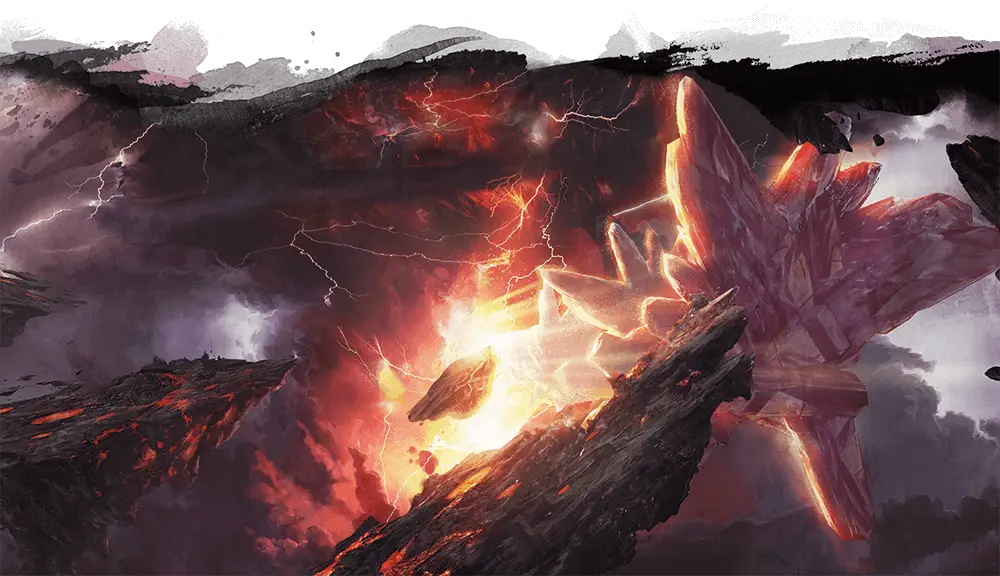
Limbo embodies the pure essence of chaos. In its natural form, no part of it remains static. It is ever shifting and flowing from one form to the next. However, sentient creatures can create momentary stability and morph the matter and energy around them according to their desires. Githzerai have taken advantage of this quirk of the plane to create the monasteries where they work and live. The Githzerai train for decades to make their will to be strong enough to maintain these large bastions and fight against the chaos.
Primus, the god of the Modrons, attempted to tame the chaos of Limbo through a gem of pure law that it sent adrift through the plane. While it created the ability for willed minds to tame the chaos, it also created the Slaad, a species of frog-like monsters that reproduce by implanting their eggs in sentient beings. When these creatures escape into the Material Plane, it can cause a horrific plague as the Slaad spread through planting their eggs in the bodies of sentient creatures.
Arriving on Limbo unprepared can throw the characters into a dangerous situation. They could find themselves entering into a fire, lightning, or ice storm. They could teleport into a ball of water or solid earth. They could even drop right into a Slaad swarm or Githzerai monastery who don’t take kindly to unannounced visitors.
Reasons to visit Limbo:
- Seeking out a Githzerai bastion for help or to return a lost monk
- Helping a group of Modron establish a bastion while fighting off a Slaadi siege
- Hunting for the Spawning Stone to end a Slaadi plague at the source
- Hunting down a wizard’s sanctuary to bring them to justice
| Deities | Creatures |
|---|---|
| Gods of Trickery or War | Slaad |
| Merrshaulk of the Yuan-ti PantheonNC | Githzerai |
| ModronNC |
Pandemonium, CE/CN
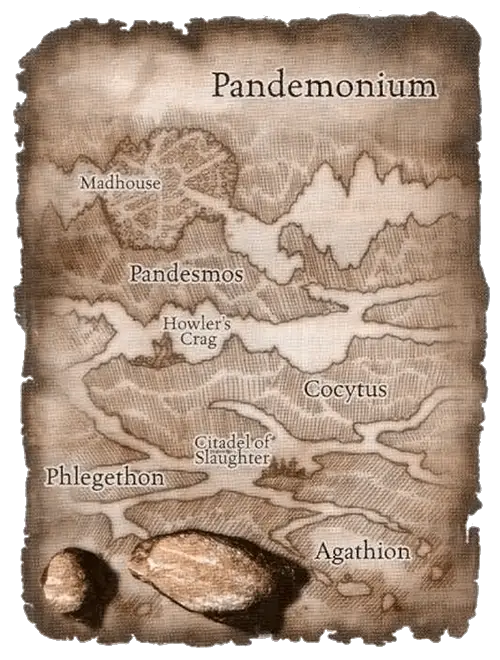
Pandemonium is windswept, draped in shadow, and maddeningly noisey. An underground plane, unceasing, howling winds have carved innumerable tunnels and caverns. Due to this wind, creatures can only communicate through shouting, and all fires are extinguished immediately. Any other kind of light can be seen for miles along the tunnels on this plane and will undoubtedly attract unwanted attention from the denizens of the plane. Some parts of this plane are miles-long tunnels, some are caverns filled with cries and wails drifting with the shrill wind, and some are wet, carved as much by dark, flowing water as the wind.
Reasons to visit Pandemonium:
- Rescuing a lost creature banished to this plane
- Escaping your banishment to this plane
- Putting down a mad cult whose base is a citadel on the plane
| Deities | Creatures |
|---|---|
| Banished gods | DemonsNC |
| Gods of Darkness or Madness | Exiled DevilsNC |
| Hurggek of the Bugbear PantheonNC |
The Abyss, CE
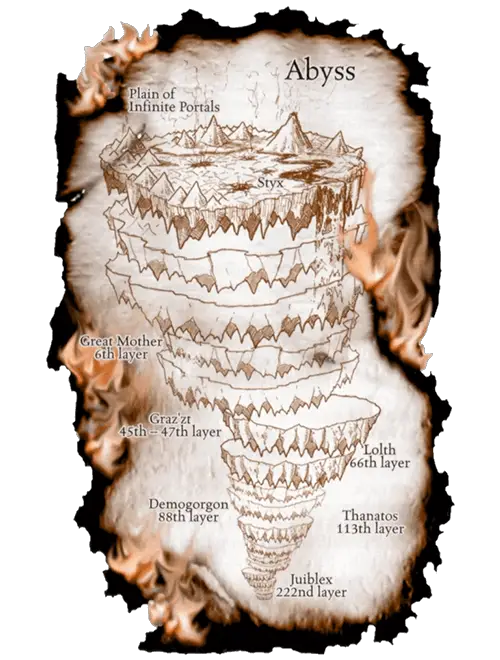
A realm of pure, destructive chaos, the Abyss has potentially infinite layers, each unique in its horrific presentation. Among the many layers, a few have greater significance due to being ruled over by named Demon Lords. Demons themselves are mostly spawned out of the corruption of the abyss. Occasionally, they come from cursed mortal souls or fallen powers. The scale of destruction that comes when a demon rampages across other planes can cause planar forces that are normally at odds to put aside their hatred to destroy a common threat. Similarly, armies that raid the Abyss can be made up of a wide variety of interplanar creatures.
Notable Abyss Layers and respective Demon Lords:
- The Gaping Maw, ruled by Demogorgon, a realm of dense jungles and brine flats.
- Thanatos, ruled by Orcus, a bleak realm of barren mountains, moors, cities, and forests.
- The Demonweb, ruled by Lolth, a realm of networks of webbing spanning multiple layers.
- The Endless Maze, ruled by Baphomet, a labyrinthian realm.
- The Triple Realm, ruled by Graz’zt, a realm composed of three layers of the abyss saturated in dark excess.
- Death Dells, ruled by Yeenoghu, a realm of blood, hunger, and the hunt.
- Shedaklah or the Slime Pits, inhabited by Zuggtmoy and Jubilex, a realm of toxic sludge.
- Hollow’s Heart, inhabited by Fraz-Urb’luu, a realm composed of a moorland of white dust.
While the named realms are the most likely to be visited, countless other realms of evil can be found or traveled through. Taking inspiration from AD&D, here are some ideas for what forms these layers can take:
- Desert Layer of black, red, or white sand
- Glacier Layer of black, white, or orange ice
- Spatial Layer of empty space and no matter
- Maelstrom Layer mimicking the chaos on Limbo
- Rocky Layer of volcanic temperament
- Underground Layer of pure, solid rock
- Water Layer of poisonous, murky, and black water
- Normal Terrain Layer that mimics the Material Plane with a dark twist, like all trees are made of human flesh
- Layer of Delusion that is a sentient being that seeks to use illusion to destroy any visitors
Reasons to visit the Abyss:
- Destroying a Demon Lord once and for all
- Fulfilling a deal with a celestial or devil to weaken a demonic army
| Deities | Creatures |
|---|---|
| The Demon Lords | Demons |
| Laogzed of the Troglodyte Pantheon | Drow and DridersNC |
| Vaprak, a troll demigodNC | Vargouilles |
| Other Monstrous DemigodsNC | |
| Lesser Deities of DestructionNC |
Carceri, NE/CE
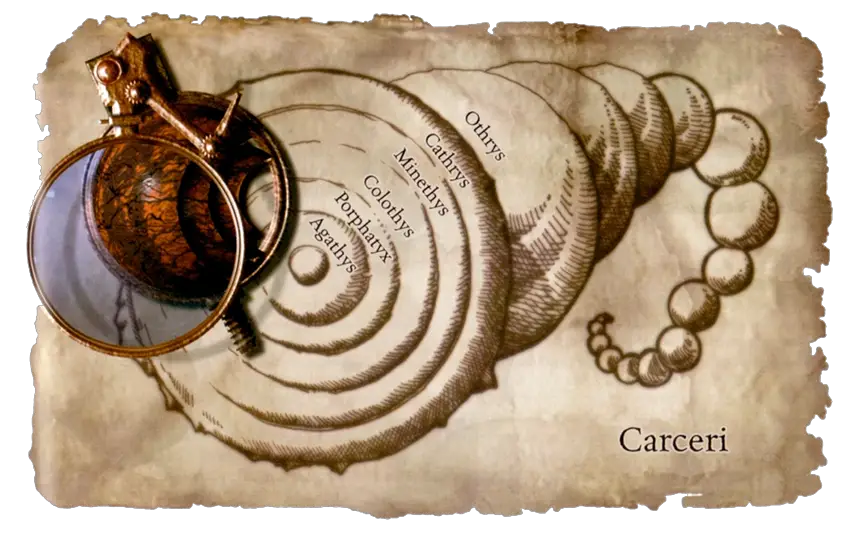
Known as Tarterus in previous editions, Carceri is a realm of prisons, seeped in desperation and despair. The layers vary wildly in presentation but all are united in a sense of resembling some kind of prison. These can be things like choking jungles, scarlet and twisting grasslands, poisonous deserts, broken and cavernous mountains, or endless freezing oceans.
Reasons to visit Carceri:
- Finding and unleashing a chained titan
- Rescuing an important soul jailed in the depths of the lowest layers
- Escorting a great power to their prison while their allies attempt to free them
| Deities | Creatures |
|---|---|
| Dendar of the Yuan-ti PantheonNC | DemonNC |
| Imprisoned gods | YugolothNC |
| Grolantor of the Giant PantheonNC | VargouillesNC |
Hades, NE

Hades is a gloomy land with an ashen sky, devoid of hope and joy, a state of waiting without end. It is a realm that sucks the warmth and color out of a soul and leaves behind a husk of despair. Souls sent here transform over time into human-headed larva who are devoured or treated as currency among the powers on this plane. Night hags make their lairs here, stealing souls from the Material Plane to fuel their dark rituals or trade for power.
There are a few different forms the gloom of Hades can take. AD&D listed three glooms: Oinos, a diseased land of withered plants that stretches without relief to the horizon; Nilfheim, a land of dreary mountains and pine forests shrouded in swirling mists; and Pluton, an oppressively gray land of black willows and dry, dying poplars.
Reasons to visit Hades:
- Rescuing a soul from a Night Hag’s clutches
- Hunting down a Lich who has escaped to the Lower Planes to recover
| Deities | Creatures |
|---|---|
| Blibdoolpoolp of the Kuo-toa PantheonNC | Night Hags |
| Yurtrus of the Orc PantheonNC | Liches |
| Gods of despair and death | Rakshasas |
| DevilsNC | |
| YugolothsNC |
Gehenna, LE/NE
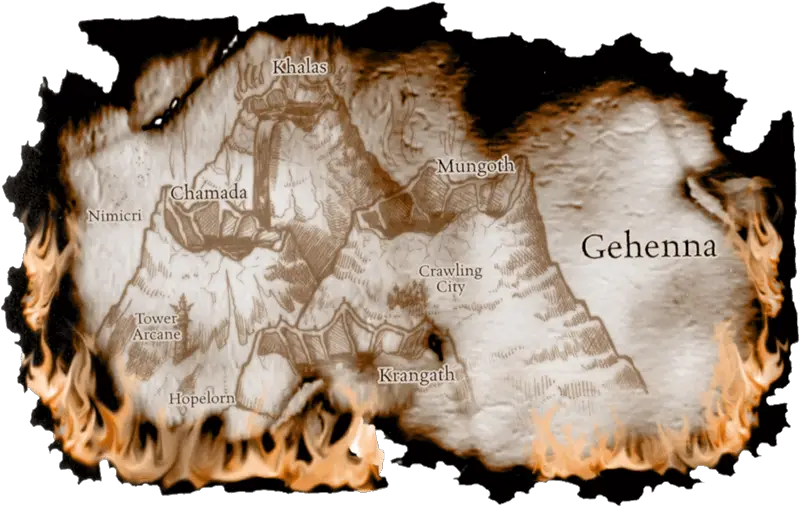
A plane of jealousy and avarice, Gehenna is the birthplace of the Yugoloths, who have been called daemons in previous editions. They are essentially a third type of fiend, alongside the devils and the demons. Driven by greed, they are most often employed as mercenaries by other planar forces.
Gehenna is a steep, mountainous realm of vents and lava flows. In AD&D, each layer was a volcano or series of volcanoes, with lesser, floating volcanic motes floating around and smashing into the slopes of the different layers. Khalas, the most temperate layer, had water flowing down the slopes. Chamada, the burning layer, had excessive lava flows and frequent eruptions. Mungoth was a layer of ash and burning snow, choked with toxic air. Finally, Krangath, the dead furnace, is pitch black with no sign of light or activity.
Reasons to visit Gehenna:
- Hiring an army of Yugoloths to fight in a war on the Material Plane
- Executing a heist in one of the many fortresses on the slopes
| Deities | Creatures |
|---|---|
| Shargaas of the Orc PantheonNC | Yugoloths |
| ArchdevilsNC | Devils out of favor with the Nine Hells |
| Barghests |
The Nine Hells, LE
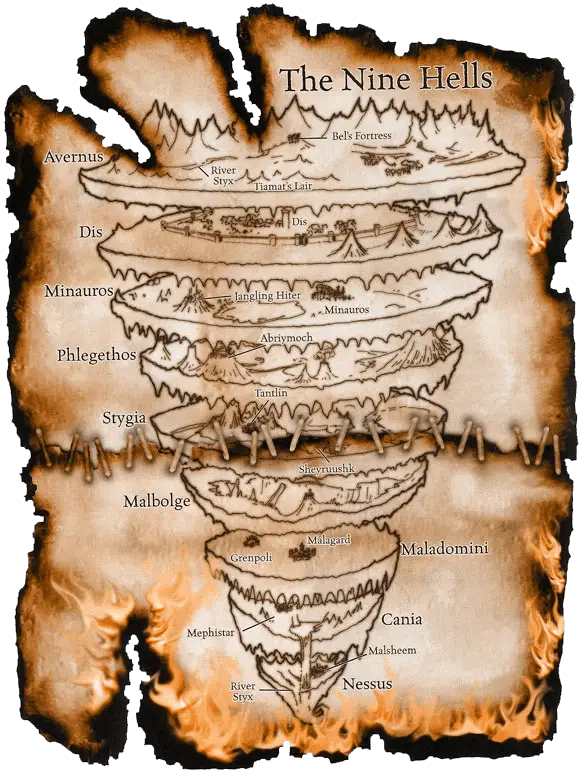
The Nine Hells are the realm of devils and rigid law. It’s separated into nine distinct layers, each ruled by their own archdevil. At the ninth level rules Asmodeus, the lord of hell. There are few non-devil powers who reside in the Nine Hells, and they are usually under contract by Asmodeus. One such deity is Tiamat, who resides on the first level along with her host of dragons and abishi. All devils are either corrupted mortal souls or fallen celestials.
All extraplanar visitors enter at the first level, Avernus. There are no planar portals that enter to lower levels. As such, to reach Asmodeus, a visitor would have to travel through all nine layers. This process is dictated by how much Asmodeus wants them to travel; one visitor could make it through all layers in a day, while another might have to take a grueling week just to travel through a single layer.
The Nine Hells are a mess of political alliances, subterfuge, and grudges. Each devil wants to elevate their status and stop the advancement of their rivals. However, hell also has a very strict structure and hierarchy, and all devils follow their contracts to the exact letter of their law. The archdukes of each layer can easily be usurped by a subordinate or replaced at the whim of Asmodeus if he believes their plots are becoming too much of a threat. Not even Asmodeus himself is safe, though he has been ruler of hell for a very long time. Very few devils show any semblance of loyalty, and usually only when their fear of demotion or death outweigh their ambition.
Each level of hell has distinct geography and architecture. While all current archdukes are devils, there have been non-devil rulers before, such as Malagard, the Hag Countess. The different layers of hell and their Archdevil masters are:
- Avernus, ruled by the Archduchess Zariel.
- A rocky wasteland with a dark red and starless sky
- Dis, ruled by the Archduke Dispater.
- An iron-rich maze of canyons and iron fortresses, lit occasionally by the dull green flickering of lightning
- Minauros, ruled by the Archduke Mammon.
- A volcanic swamp, stinking, slimy, and rich in decay
- Phlegethos, ruled by the Archduke Belial and the Archduchess Fierna.
- An infernal layer of rivers of fire, ash storms, and erupting plumes
- Stygia, ruled by the Archduke Levistus.
- A vast frozen sea beneath a jet black sky, broken only by bursts of lightning and balls of cold fire
- Malbolge, ruled by the Archduchess Glasya.
- A huge rockfall as if on the side of a mountain shrouded in clouds of blood-red steam
- Maladomini, ruled by the Archduke Baalzebul.
- A wasteland of ruins from the constant rebuilding with great quarries scarring the countryside
- Cania, ruled by the Archduke Mephistopheles.
- An icy wasteland of huge glaciers with flesh-ripping ice storms
- Nessus, ruled by the Archduke Asmodeus, the Lord of Hell.
- A realm of colossal citadels built into the sides of dark pit.
Reasons to visit the Nine Hells:
- Negotiating with Asmodeus to get a soul back
- Making a literal deal with the devil
- Seeking to beat up an Archduke to reverse the terms of a contract
- Hunting a great treasure in one of the layers
| Deities | Creatures |
|---|---|
| Tiamat and the Kobold Pantheon | Dragons |
| Archdevils | Devils |
| Sekolah of the Sahaguin PantheonNC | Nightmares |
Archeron, LN/LE
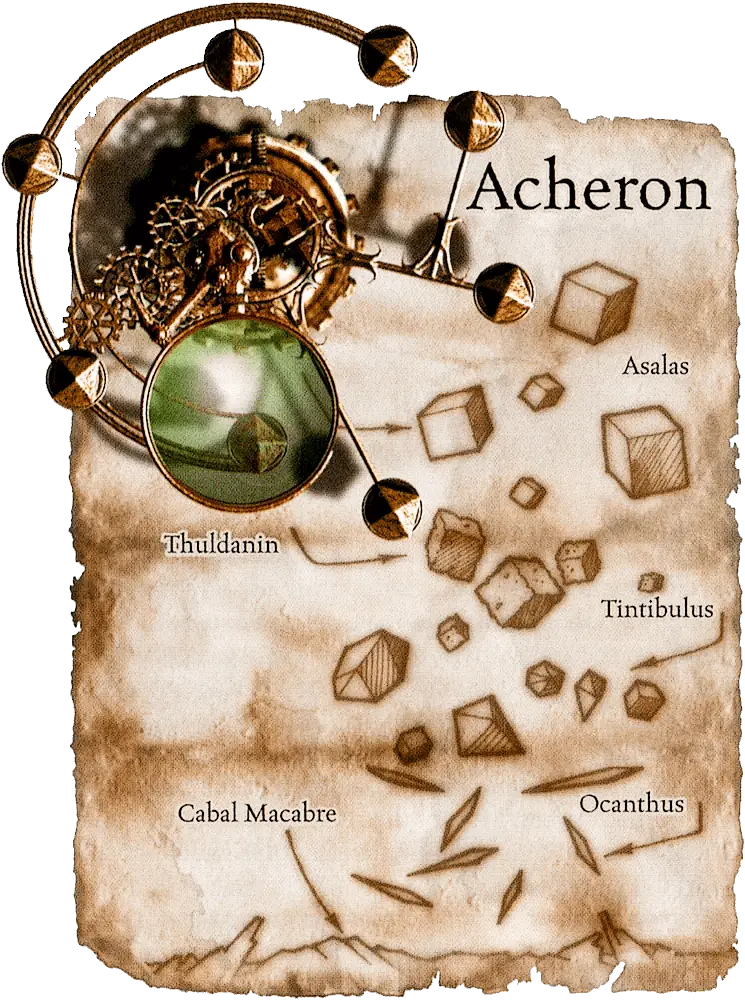
The evil plane of War, Archeron is a series of massive iron cubes floating through space. The echo of the collision of these cubes and the armies on them echo throughout the plane. These blocks can be walked about on all sides, and the residents build iron fortresses or artificial mountains across them. Most gods of war reside on this plane, locked in eternal battles amongst the iron blocks. Notably, though, are the pantheons of the Orcs and the Goblins, who wage for control over a specific iron block.
In previous editions, there were several layers to Archeron that reflected different types of floating metal. One layer was described as a scrap heap, another as blocks of many different-sides regular shapes (like the dice at your table). Another was razor-thin squares of hard black matter that can be walked on both sides and can deal massive damage to those unlucky enough to be caught between two of them colliding. The River Styx does not run through all parts of the plane, only across specific surfaces, flowing from one pit to another.
Reasons to visit Archeron:
- Fighting the various gods of war
- Tracking down the soul of a great warrior to convince them to be resurrected to fight in a great conflict on the Material Plane
| Deities | Creatures |
|---|---|
| Grolantor of the Giant PantheonNC | GiantsNC |
| Maglubiyet and the Goblinoid Pantheon | Goblins |
| Merrshaulk of the Yuan-ti PantheonNC | Yuan-tiNC |
| Rust MonstersNC |
Conclusion
Since the Lower Planes are the birthplace of devils and demons, they tend to play a more active role in many campaigns, or at least, the powers of the Lower Planes take a more active role. However, the other planes beyond the Abyss and the Nine Hells receive little attention or lore. To make up for that, consider giving them a little bit of love and including them in your next high-level adventure. Why not have the next heist be stealing from the palace of an Archdevil who built their summer home on Gehenna? Why not have the next war sequence happen on one of the massive iron cubes on Archeron? Why not have the next prison escape take place in Carceri? The Outer Planes can make an excellent adventure space for high level campaigns, allowing fantastical, surreal, and mind-bending geography and physics and plenty of high-level monsters to clash with.

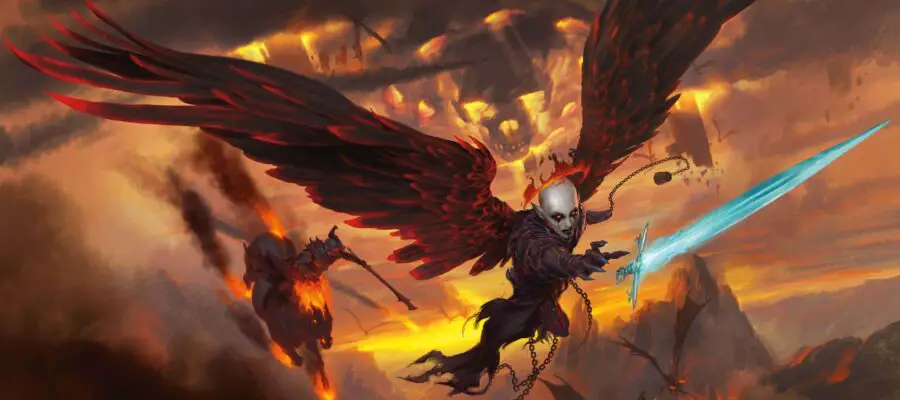
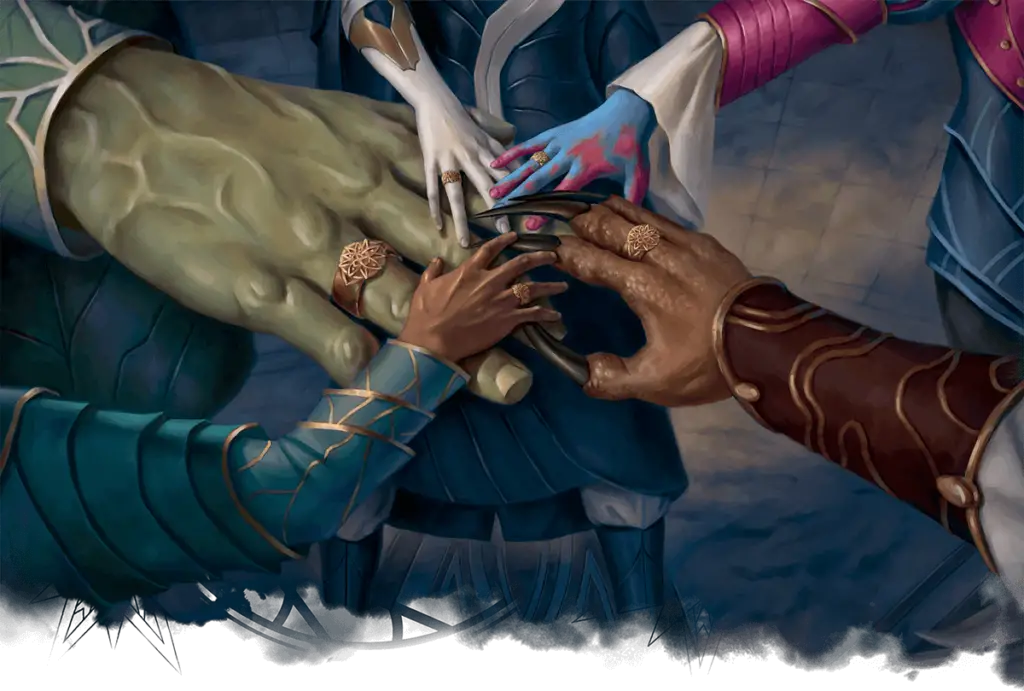


Great stuff!
Added to the Blog Database.